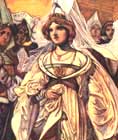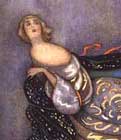
Cinderella:
345 Variants
by Marian
Roalfe Cox
SurLaLune's
Cinderella Area
SurLaLune Fairy Tales Main Page
338
Stier, G., Ungarische Sagan and Märchen. Berlin, 1850. pp. 91-95. No. XIV. (From Pesth.)
"ASCHENBRODEL."1
ABSTRACT
Peasants' two elder sons, sent to mind vines, refuse cake to toad, and fall asleep. Vines are trampled down. Despised youngest son, called Aschenbrödel, asks to guard vines; gives cake to Helpful animal (toad), and receives copper, silver, gold switches with which to tame the copper, silver, gold horses that trample vines-- Princess as prize to anyone who can reach (1) rosemary on top of fir-pole, (2) gold apple on higher pole, (3) silk kerchief on highest pole-- Magic armour, copper, silver, golden-- Hero performs feats on copper, silver, gold horses-- Fence, stable, and roof pulled down, because hero tells brother he saw stranger knight thence-- Trophy marriage tests-- Happy marriage.
TABULATION
(1) Peasant has three sons. He sends the eldest to mind his vines. A toad asks him for a piece of his cake, he refuses to give it, throws a stone at toad, and falls asleep. When he wakes up a number of the vines have been trampled down. Same thing happens next day when second son is sent.-- (2) On the third day the youngest son, who is called Aschenbrödel, because he sits in the ashes, and is considered good for nothing, asks to be sent to keep guard over the grapes. They laugh at him, but let him go and try. He willingly spares some cake for the toad, who gives him a copper, a silver, and a golden switch, and tells him that ere long three horses, copper, silver, and gold, will come to tread down the vines; but he has only to strike the horses with the three switches, and they will become tame and obedient, and will afterwards appear at command, So it happens; and there is a fine harvest of grapes; but Aschenbrodel does not tell father how he guarded them.-- (3) One Sunday the king places a high fir-pole in front of the church, and on the top of it a gold rosemary, and promises his daughter to the man who can reach the rosemary with one spring from his horse's back. All the knights in the land make the attempt, but none can jump high enough. A young knight in copper armour on a copper horse seizes the rosemary at an easy bound, and vanishes.-- (4) When the brothers return home and tell Aschenbrodel, he says he saw the whole thing much better from the fence. Brothers pull it down.-- (5) Next Sunday a gold apple is placed on the top of a still higher pole. Hundreds try in vain to reach it. It is carried off by a knight in silver armour on a silver steed.-- (6) Aschenbrodel tells brothers he saw capitally from the stable, which is accordingly pulled down.-- (7) Third Sunday a golden silk kerchief is placed on a much higher pole, and it is carried off by a knight in gold armour on a gold steed.-- (8) Aschenbrodel tells brothers he saw all from the ledge of the roof. They break it down.-- (9) King proclaims that the knight who has deserved his daughter should make himself known by bringing the rosemary, the apple, and the kerchief. No one comes. Then king invites all the men in the kingdom to come and see him; but the stranger knight is not amongst them.-- (10) At last he appears in golden apparel on golden steed. Bells ring, cannons sound. Hero gives the trophies to princess, takes off his helmet, and is recognised as Aschenbrödel by the astonished populace.-- (11) Hero marries king's daughter, rebuilds house for brothers, and takes father to live with him. Bride's father soon dies, and Aschenbrodel inherits all.
NOTES
Note 76
(P. 459.) This story is the same as "Cinder Jack" in Magyar Folk-tales, by Jones and Kropf. The Magyar title is "Hamupipöke", and as there are no genders in the Magyar language, the name may stand either for a male or a female.
Cf. the Finnish story from Ilomantsi (Satuja ja Tarinoita, ii, p. 22), entitled "Maan, meren kulkija laiwa", which tells of a king wilth an only daughter. Anyone wishing to marry her must build a ship that can sail over land and sea. Three brothers, who are merchants, try to win her. The elder fail because they reject an old man's proffered help; the youngest, who is called Tuhkamo (Ashiepattle), secures the old man's goodwill, and is successful.
Compare also Dasent's "Princess on the Glass Hill". Stories of the princess on the glass mountain (as in Nos. 329, 332), or other inaccessible height (as in Nos. 319, 336, 341), recall the deliverance of Brunhild. The hall of flames of the Norse saga is the glass mountain which only a particular horse (Grani) can ascend, in the Danish ballad of Bryniel (Altdanische Lieder und Märchen, p. 31, and notes pp. 496, 497). For other examples of the glass mountain, cf. Bechstein, Sagen, p. 67; Campbell, iv, 295; F.-L. Rec., iii, 225; F.-L. Journal, iii, 188; vi, 199; Grimm, Nos. 25 and note, 53, 93, 127; Magyar Folk-Tales, p. 59; Müllenhoff, p. 386-7; Thorpe, p. 86, "Princess on the Glass Mountain"; Vernaleken, pp. 50, 275 and note, 280, 289, 355; Zingerle, p. 239. Compare the belief that the soul in its wanderings has to climb a steep hill-side, sometimes supposed to be made of iron, sometimes of glass, on the summit of which is the heavenly Paradise. For this reason the nails of a corpse must never be pared. The Russians still carry about with them parings of an owl's claws, and of their own nails (see Ralston's Songs of the Russian People, p. 109-10).
The Lithuanians bury or burn with the dead the claws of a lynx or bear, in the belief that the soul has to climb up a steep mountain (Wojcicki, Klechdy, ii, 134-5). In Vernaleken's "The Maiden on the Crystal Mountain" (from Lower Austria), the hero who keeps sliding backward when he attempts to climb the glass mountain, changes himself into a bear (by means of the hair given him by a grateful bear), and digs steps with his paws. When the splinters of glass lame him he changes himself into a wolf, and holds fast with his teeth. Finally he changes himself into a raven, and flies to the top. The steep hill is called Anafielas by the Lithuanians, and Szklanna gora (glass mountain) by the Poles.
A glass mountain occurs in the "Younger Titurel" (Str., 6177). King Arthur dwells with Morgan le fay on the glass island. A glass house in the air occurs as early as Tristan (ed. Michel, ii, 103; cf. i, 222). There is a glass forest in Gypsy-lore Journal, iii, 81.
In the folk-tales there is no distinct connection between
the glass mountain and the abode of the dead, except that in Grimm's No.
25, "The Ravens", the little girl may be supposed to be
seeking her lost brothers in the underworld. There is the Norse glerhiminn
(coelum vitreum), a paradise to which old heroes ride. (See Grimm, T.
M., p. 820, note.)
Return to place in text.
Cox, Marian Roalfe. Cinderella: Three Hundred and Forty-five Variants of Cinderella, Catskin, and Cap O' Rushes, abstracted and tabulated. London: David Nutt for the Folklore Society, 1893.
While the original text of this book is out of copyright, the special formatting and compilation available on SurLaLune Fairy Tales is copyrighted. Be aware that while the original content has been honored, page numbering, footnote numbering, redesigned charts, links, and other aspects are unique to this site's version of the text. Use at your own risk. For private and fair use educational purposes only.
©Heidi
Anne Heiner, SurLaLune Fairy Tales
E-mail: surlalune@aol.com
Page last updated March 2, 2006
www.surlalunefairytales.com










